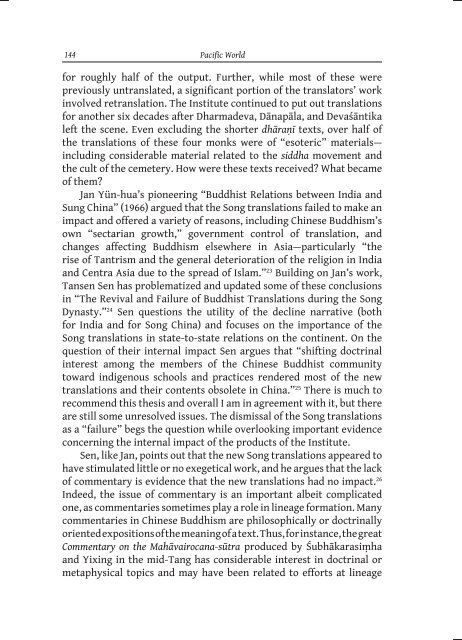Looking for Bhairava - The Institute of Buddhist Studies
Looking for Bhairava - The Institute of Buddhist Studies
Looking for Bhairava - The Institute of Buddhist Studies
- No tags were found...
You also want an ePaper? Increase the reach of your titles
YUMPU automatically turns print PDFs into web optimized ePapers that Google loves.
144Pacific World<strong>for</strong> roughly half <strong>of</strong> the output. Further, while most <strong>of</strong> these werepreviously untranslated, a significant portion <strong>of</strong> the translators’ workinvolved retranslation. <strong>The</strong> <strong>Institute</strong> continued to put out translations<strong>for</strong> another six decades after Dharmadeva, Dānapāla, and Devaśāntikaleft the scene. Even excluding the shorter dhāraṇī texts, over half <strong>of</strong>the translations <strong>of</strong> these four monks were <strong>of</strong> “esoteric” materials—including considerable material related to the siddha movement andthe cult <strong>of</strong> the cemetery. How were these texts received? What became<strong>of</strong> them?Jan Yün-hua’s pioneering “<strong>Buddhist</strong> Relations between India andSung China” (1966) argued that the Song translations failed to make animpact and <strong>of</strong>fered a variety <strong>of</strong> reasons, including Chinese Buddhism’sown “sectarian growth,” government control <strong>of</strong> translation, andchanges affecting Buddhism elsewhere in Asia—particularly “therise <strong>of</strong> Tantrism and the general deterioration <strong>of</strong> the religion in Indiaand Centra Asia due to the spread <strong>of</strong> Islam.” 23 Building on Jan’s work,Tansen Sen has problematized and updated some <strong>of</strong> these conclusionsin “<strong>The</strong> Revival and Failure <strong>of</strong> <strong>Buddhist</strong> Translations during the SongDynasty.” 24 Sen questions the utility <strong>of</strong> the decline narrative (both<strong>for</strong> India and <strong>for</strong> Song China) and focuses on the importance <strong>of</strong> theSong translations in state-to-state relations on the continent. On thequestion <strong>of</strong> their internal impact Sen argues that “shifting doctrinalinterest among the members <strong>of</strong> the Chinese <strong>Buddhist</strong> communitytoward indigenous schools and practices rendered most <strong>of</strong> the newtranslations and their contents obsolete in China.” 25 <strong>The</strong>re is much torecommend this thesis and overall I am in agreement with it, but thereare still some unresolved issues. <strong>The</strong> dismissal <strong>of</strong> the Song translationsas a “failure” begs the question while overlooking important evidenceconcerning the internal impact <strong>of</strong> the products <strong>of</strong> the <strong>Institute</strong>.Sen, like Jan, points out that the new Song translations appeared tohave stimulated little or no exegetical work, and he argues that the lack<strong>of</strong> commentary is evidence that the new translations had no impact. 26Indeed, the issue <strong>of</strong> commentary is an important albeit complicatedone, as commentaries sometimes play a role in lineage <strong>for</strong>mation. Manycommentaries in Chinese Buddhism are philosophically or doctrinallyoriented expositions <strong>of</strong> the meaning <strong>of</strong> a text. Thus, <strong>for</strong> instance, the greatCommentary on the Mahāvairocana-sūtra produced by Śubhākarasiṃhaand Yixing in the mid-Tang has considerable interest in doctrinal ormetaphysical topics and may have been related to ef<strong>for</strong>ts at lineage
















